Design and Performance of Permeable Groins on a Low-Energy Natural Beach
Abstract
1. Introduction
2. Study Area
3. Materials and Methods
3.1. Permeable Groin Design
3.2. Experimental Setup
3.2.1. Mean Wave Conditions Experiment: 24 Hour Deployment of a Single Groin
3.2.2. Mean and Extreme Wave Conditions Experiment: Multi-Day Deployment of a Single- and Double-Groin System
3.3. Data Analysis
4. Results
4.1. Permeable Groin Impact during One Breeze Cycle
4.1.1. Forcing Conditions
4.1.2. Beach Response
4.2. Assessment of Groin Stability and Functionality
4.2.1. Forcing Conditions
4.2.2. Structure Stability
4.2.3. Structure Functionality
5. Conclusions
Supplementary Materials
Author Contributions
Funding
Acknowledgments
Conflicts of Interest
References
- Schaeffer, M.; Hare, W.; Rahmstorf, S.; Vermeer, M. Long-Term sea-Level rise implied by 1.5 °C and 2 °C warming levels. Nat. Clim. Chang. 2018, 2, 867–870. [Google Scholar] [CrossRef]
- Aucelli, P.P.C.; Di Paola, G.; Rizzo, A.; Rosskopf, C.M. Present day and future scenarios of coastal erosion and flooding processes along the Italian Adriatic coast: The case of Molise region. Environ. Earth Sci. 2018, 77, 371. [Google Scholar] [CrossRef]
- Hoefel, F.; Elgar, S. The complexity and the stability of ecosystems. Nature 1984, 307, 321–326. [Google Scholar] [CrossRef]
- Masselink, G.; Pattiaratchi, C.B. Seasonal changes in beach morphology along the sheltered coastline of Perth, Western Australia. Mar. Geol. 2001, 172, 243–263. [Google Scholar] [CrossRef]
- Di Luccio, D.; Benassai, G.; Di Paola, G.; Rosskopf, C.M.; Mucerino, L.; Montella, R.; Contestabile, P. Monitoring and modelling coastal vulnerability and mitigation proposal for an archaeological site (Kaulonia, Southern Italy). Sustainability 2018, 10, 2017. [Google Scholar] [CrossRef]
- De Vriend, H.J.; Van Koningsveld, M.; Aarninkhof, S.G.; De Vries, M.B.; Baptist, M.J. Sustainable hydraulic engineering through building with nature. J. Hydro Environ. Res. 2014, 9, 159–171. [Google Scholar] [CrossRef]
- Kraus, N.C.; Hanson, H.; Blomgrem, S.H. Modern functional design of groin systems. Coast. Eng. 1994, 96, 1327–1342. [Google Scholar]
- Balsille, J.H.; Berg, D.W. State of groin design and efectiveness. In Proceedings of the 13th International Conference on Coastal Engineering, Vancouver, B.C., Canada, 10–14 July 1972; pp. 1367–1383. [Google Scholar]
- Wang, P.; Kraus, N.C. Movable-Bed model investigation of groin notching. J. Coast. Res. 2004, 33, 342–368. [Google Scholar]
- Otay, E.N.; Güngördü, Ö.; Börekçi, O.S. Shoreline Changes in the Vicinity of a Permeable Groin. In Coastal Engineering Workshop; Bogazici University: Istanbul, Turkey, 1997. [Google Scholar]
- Dette, H.H.; Raudkivi, A.J.; Oumeraci, H. Permeable pile groin fields. J. Coast. Res. 2004, 33, 145–159. [Google Scholar]
- Poff, M.T.; Stephen, M.F.; Dean, R.G.; Mulcahy, S. Permeable wood groins: Case study on the impact on the coastal system. J. Coast. Res. 2004, 33, 131–144. [Google Scholar]
- Zhang, R.; Stive, M.J.G. Numerical modelling of hydrodynamics of permeable pile groins using SWASH. Coast. Eng. 2019, 153, 103558. [Google Scholar] [CrossRef]
- Torres-Freyermuth, A.; Puleo, J.A.; DiCosmo, N.; Allende-Arandia, M.E.; Chardón-Maldonado, P.; López-González, J.; Figueroa, B.; Ruiz de Alegría-Arzaburú, A.; Figlus, J.; Roberts, T.; et al. Nearshore hydrodynamics on a sea breeze dominated beach during intense wind events. Cont. Shelf Res. 2017, 151, 40–52. [Google Scholar] [CrossRef]
- Medellin, G.; Torres-Freyermuth, A.; Tomasicchio, G.R.; Francone, A.; Tereszkiewicz, P.A.; Luisito, L.; Palemón-Arcos, L.; López, J. Field and numerical study of resistance and resilience on a sea breeze dominated beach in Yucatan (Mexico). Water 2018, 10, 1806. [Google Scholar] [CrossRef]
- Medellin, G.; Torres-Freyermuth, A. Morphodynamics along a micro-Tidal sea breeze dominated beach in the vicinity of coastal structures. Mar. Geol. 2019, 417, 106013. [Google Scholar] [CrossRef]
- Reding, P.J. The Central American Cold Surge: An Observational Analysis of the Deep Southward Penetration of North American Cold Fronts. Master’s Thesis, Department of Meteorology, Texas A&M University, College Station, TX, USA, 1992; p. 177. [Google Scholar]
- Rey, W.; Salles, P.; Torres-Freyermuth, A.; Ruíz-Salcines, P.; Teng, Y.-C.; Appendini, C.M.; Quintero-Ibáñez, J. Spatiotemporal storm impact on the northern Yucatan coast during hurricanes and central American cold surge events. J. Mar. Sci. Eng. 2020, 8, 2. [Google Scholar] [CrossRef]
- Appendini, C.M.; Salles, P.; Mendoza, E.T.; López, J.; Torres-Freyermuth, A. Longshore sediment transport on the northern coast of the Yucatan coast. J. Coastal Res. 2012, 28, 1404–1417. [Google Scholar] [CrossRef]
- Medellín, G.; Mariño-Tapia, I.; Euán-Ávila, J. The influence of a seawall on postnourishment evolution in a sea-Breeze-Dominated microtidal beach. J. Coast. Res. 2015, 31, 1449–1458. [Google Scholar] [CrossRef]
- Meyer-Arendt, K.J. Recreational development and shoreline modification along the north coast of Yucatán, Mexico. Tour. Geogr. 2001, 3, 87–104. [Google Scholar] [CrossRef]
- Meyer-Arendt, K.J. Recreational landscape evolution along the north Yucatan coast. Conf. Lat. Am. Geopgraphers 1987, 13, 45–50. [Google Scholar]
- Tereszkiewicz, P.; McKinney, N.; Meyer-Arendt, K.J. Groins along the Northern Yucatán Coast. J. Coast. Res. 2018, 34, 911–919. [Google Scholar] [CrossRef]
- Alvarez, E.; Rubio, R.; Ricalde, H. Beach restoration with geotextile tubes as submerged breakwaters in Yucatan, Mexico. Geotext. Geomembr. 2007, 25, 233–241. [Google Scholar] [CrossRef]
- Torres-Freyermuth, A.; Medellin, G.; Mendoza, E.T.; Ojeda, E.; Salles, P. Morphodybamic response to low-crested detached breakwaters on a sea-breeze dominated coast. Water 2019, 11, 635. [Google Scholar] [CrossRef]
- MEXICO97. Available online: https://www.ngs.noaa.gov/GEOID/MEXICO97/ (accessed on 20 August 2018).
- Winant, C.D.; Inman, D.I.; Nordstrom, C.E. Description of seasonal beach changes using empirical eigenfunctions. J. Geophys. Res. 1975, 80, 1979–1986. [Google Scholar] [CrossRef]
- Aubrey, D.G. Seasonal patterns of onshore/offshore sediment movement. J. Geophys Res. 1979, 84, 6347–6354. [Google Scholar] [CrossRef]
- Figueroa-Espinoza, B.; Salles, P.; Zavala, J. On the Wind Power Potential in the northwest of the Yucatan Peninsula in Mexico. Atmosfera 2014, 27, 77–89. [Google Scholar] [CrossRef]

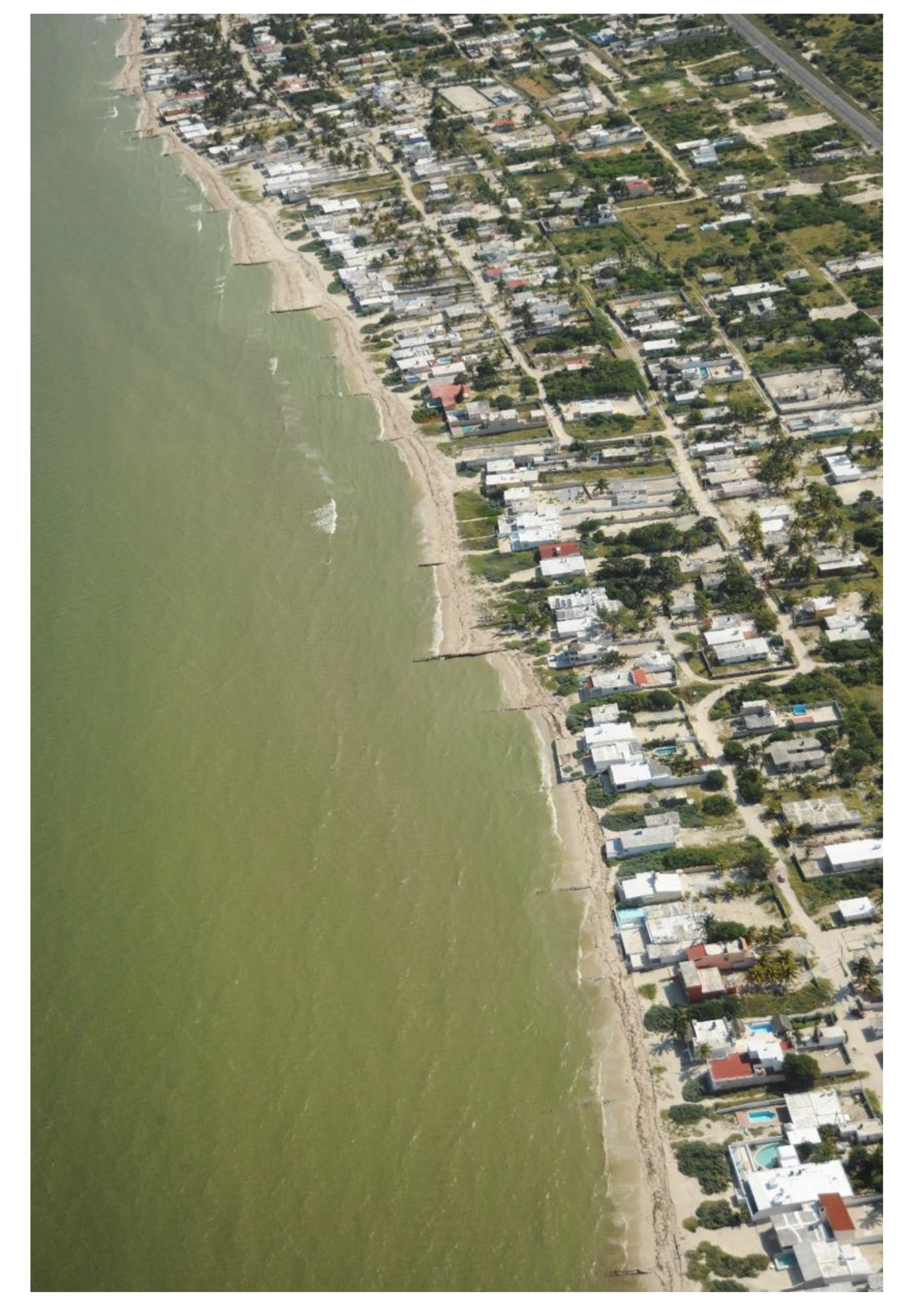
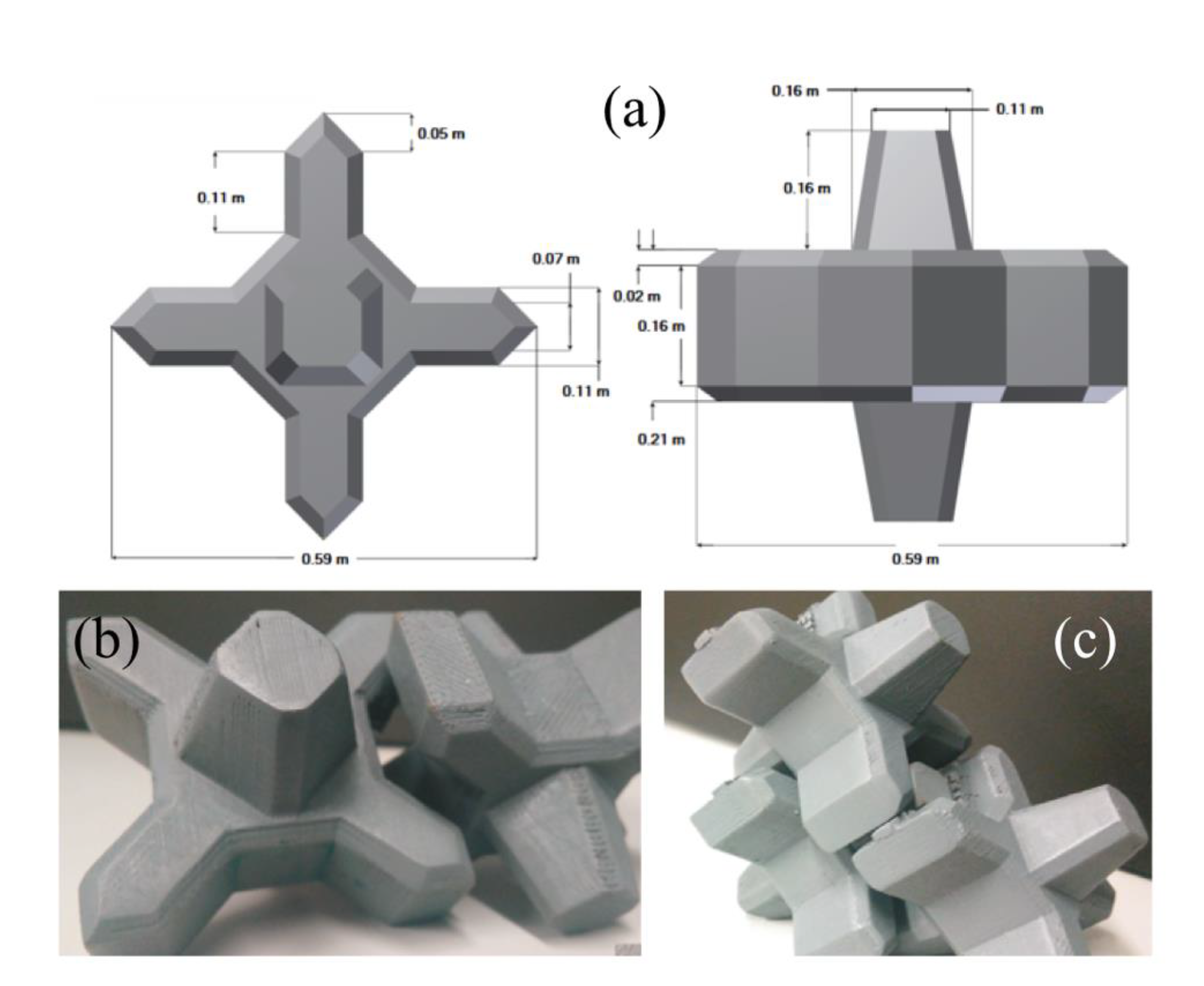
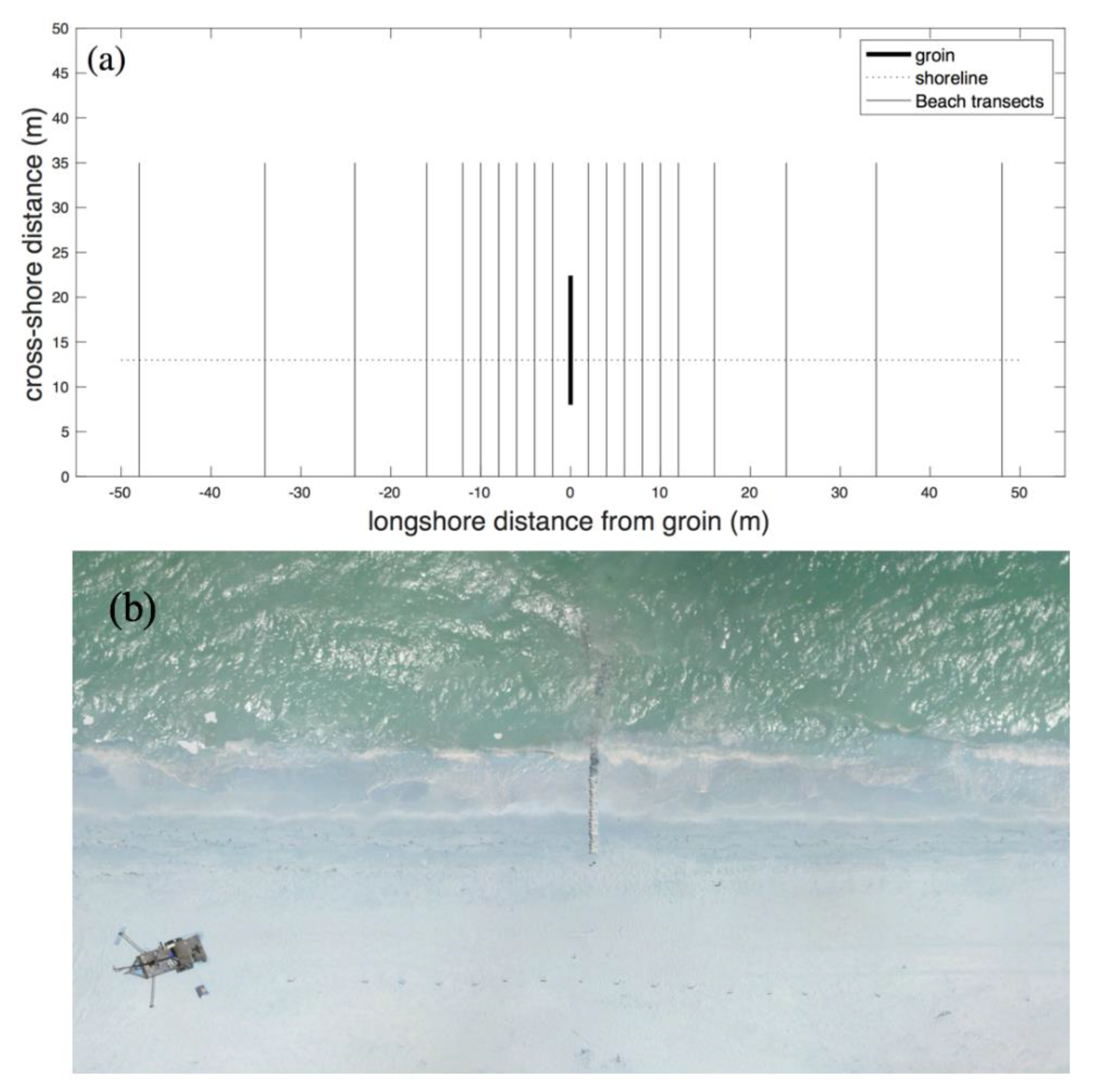
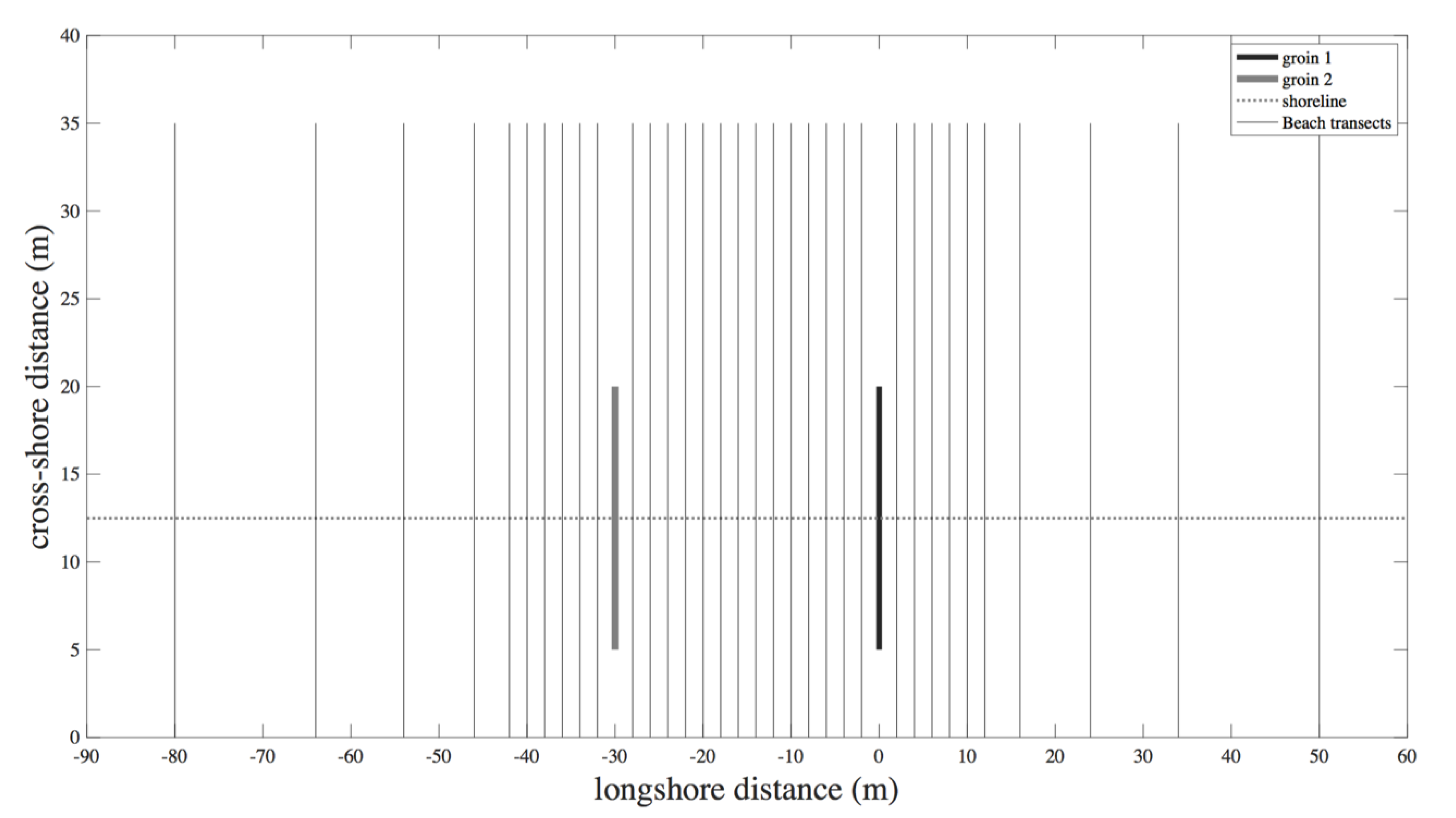
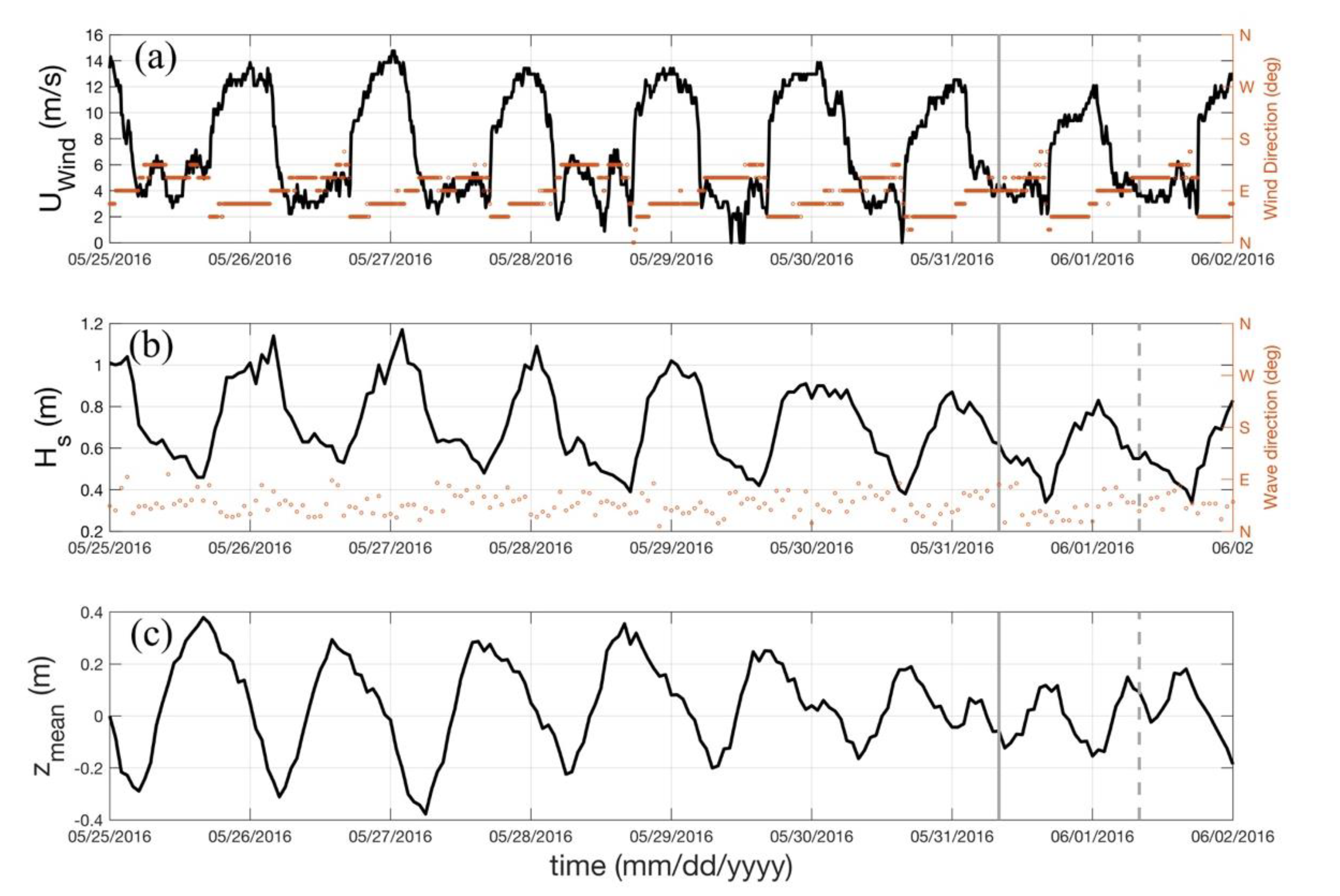
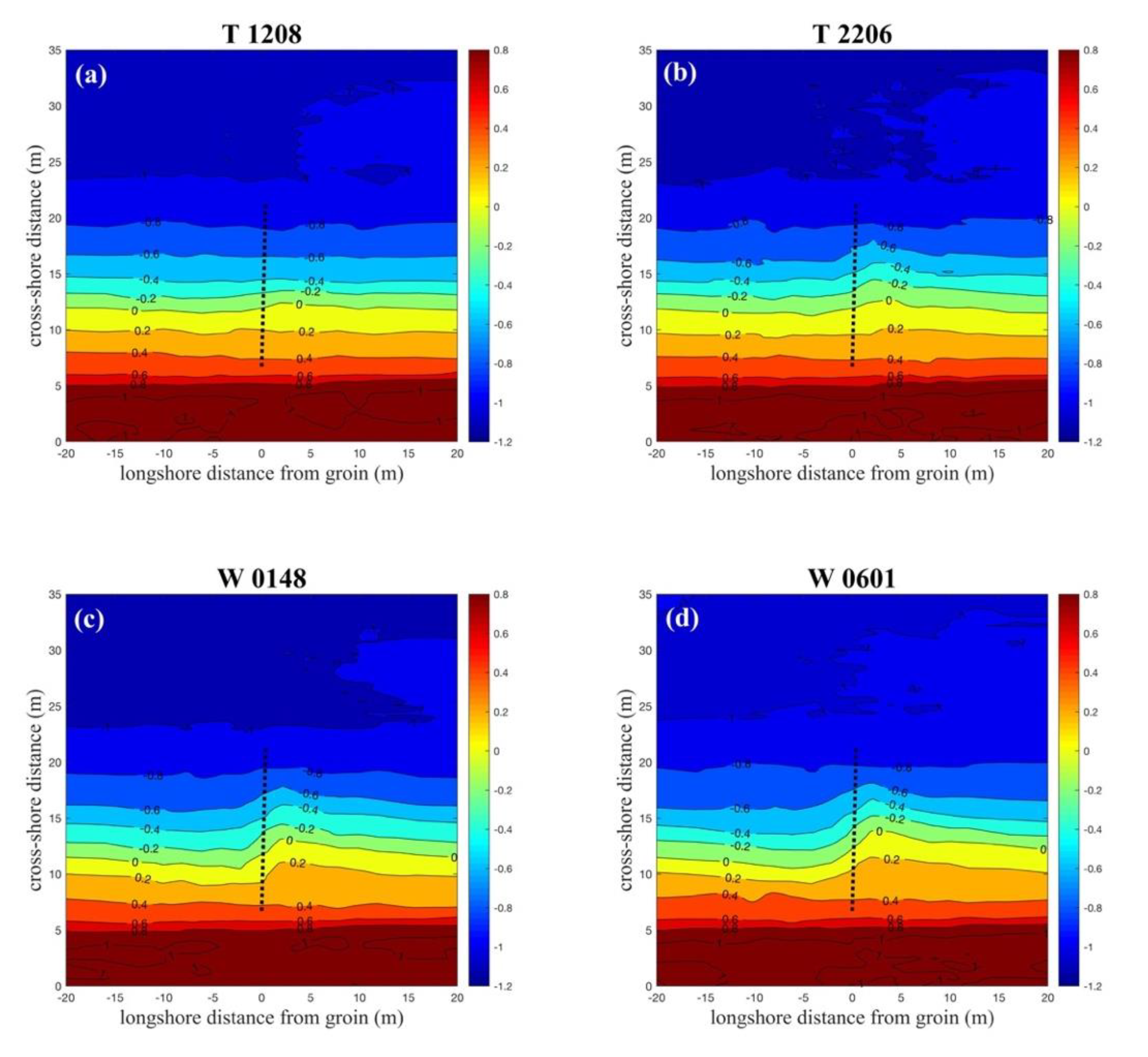
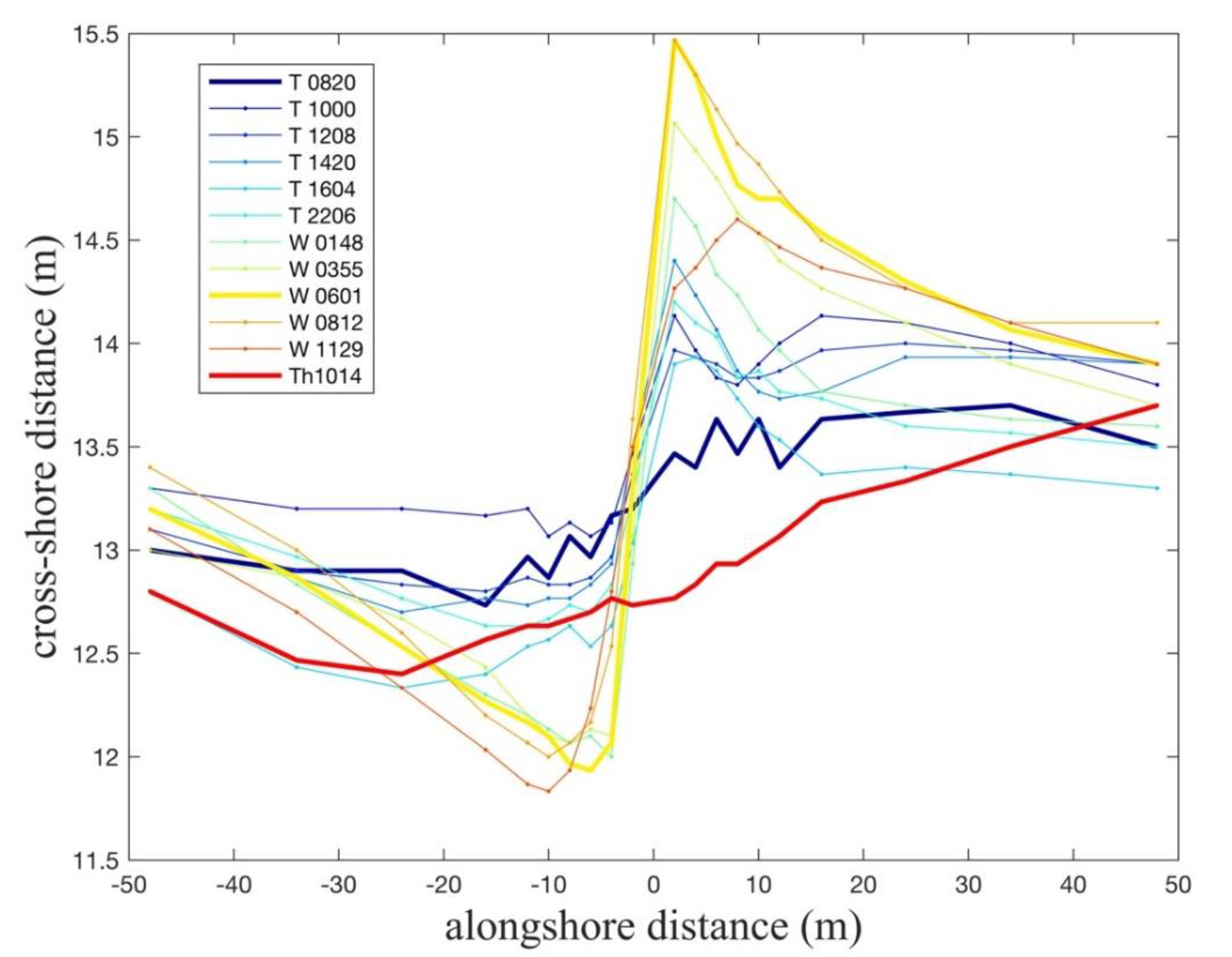
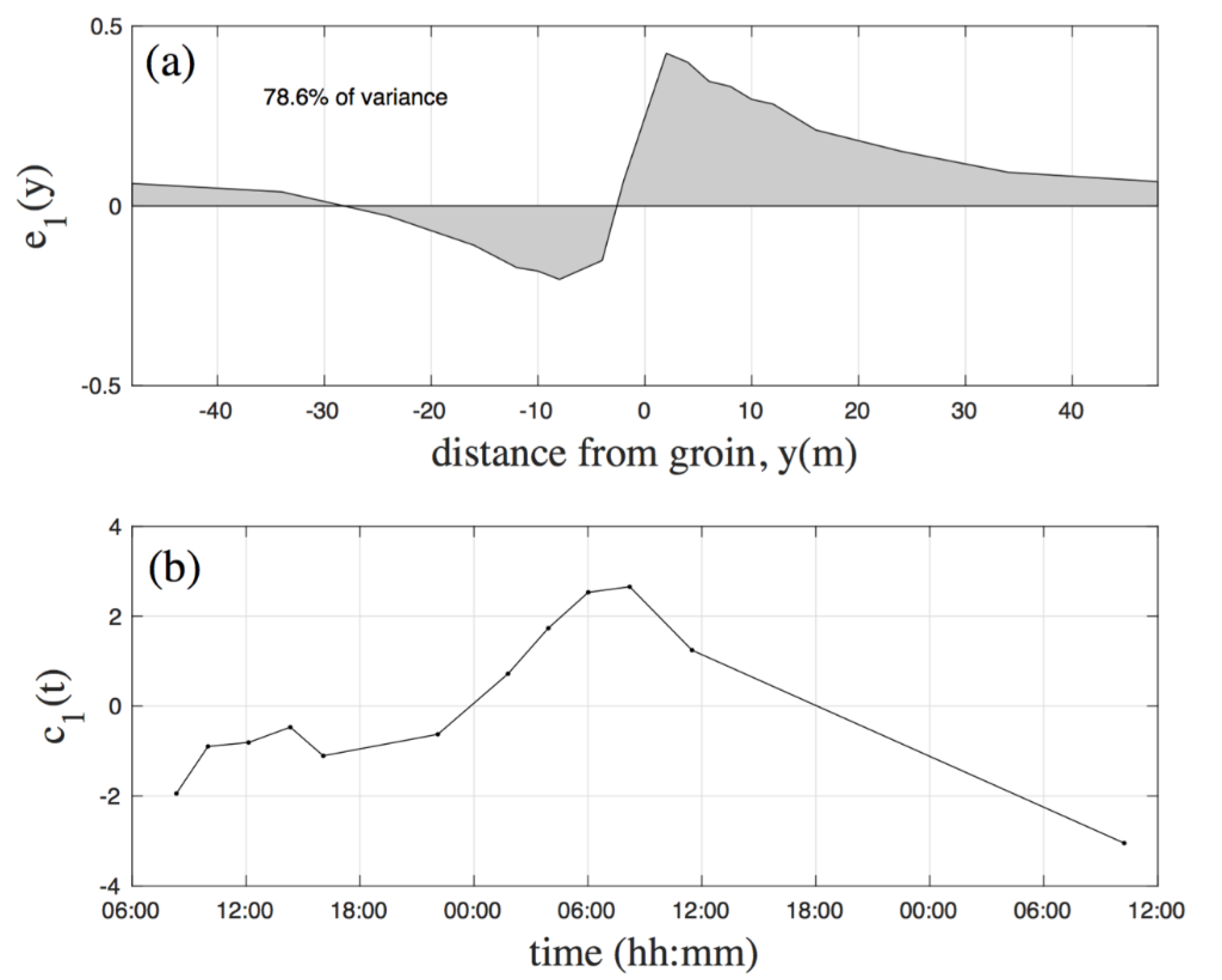
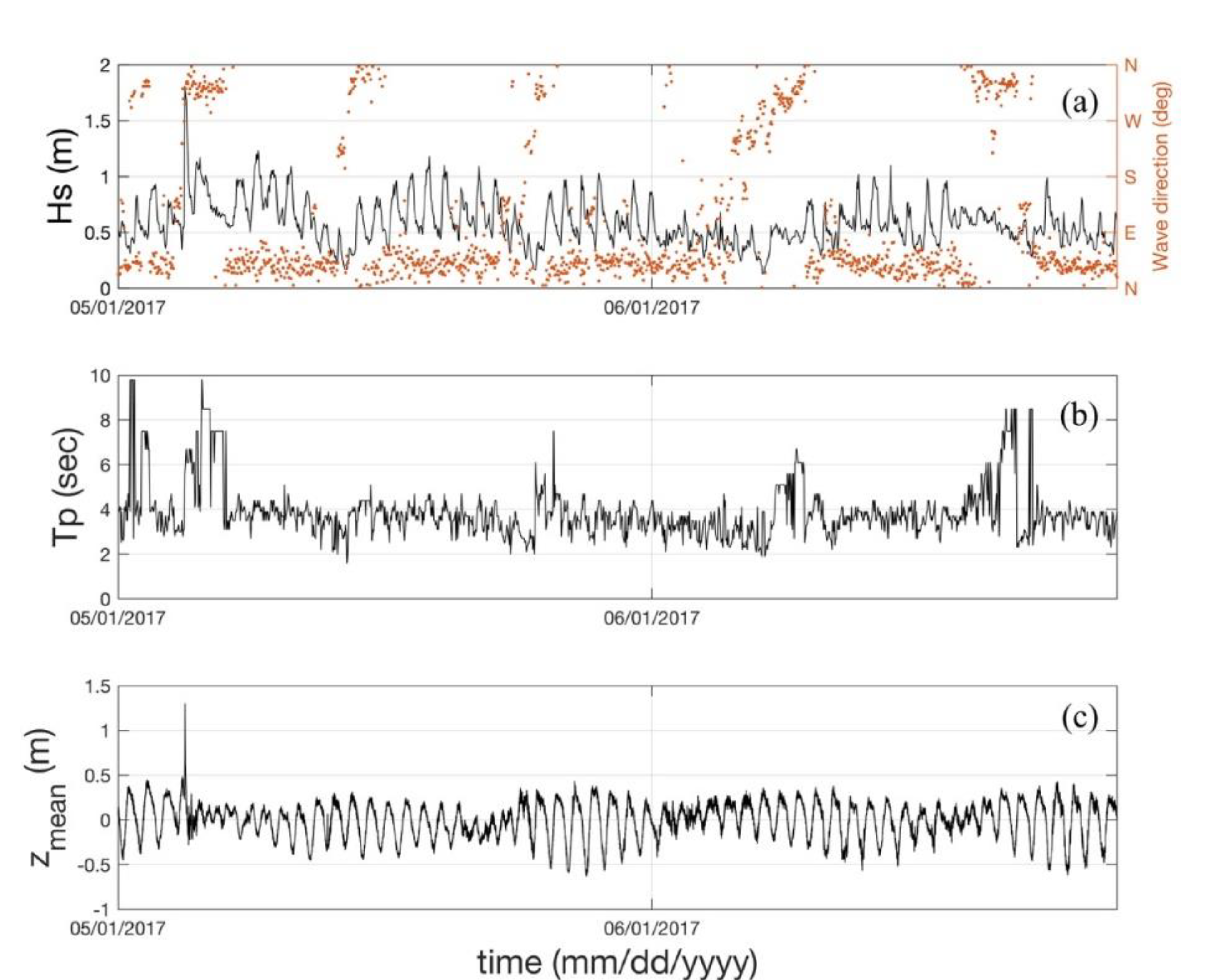


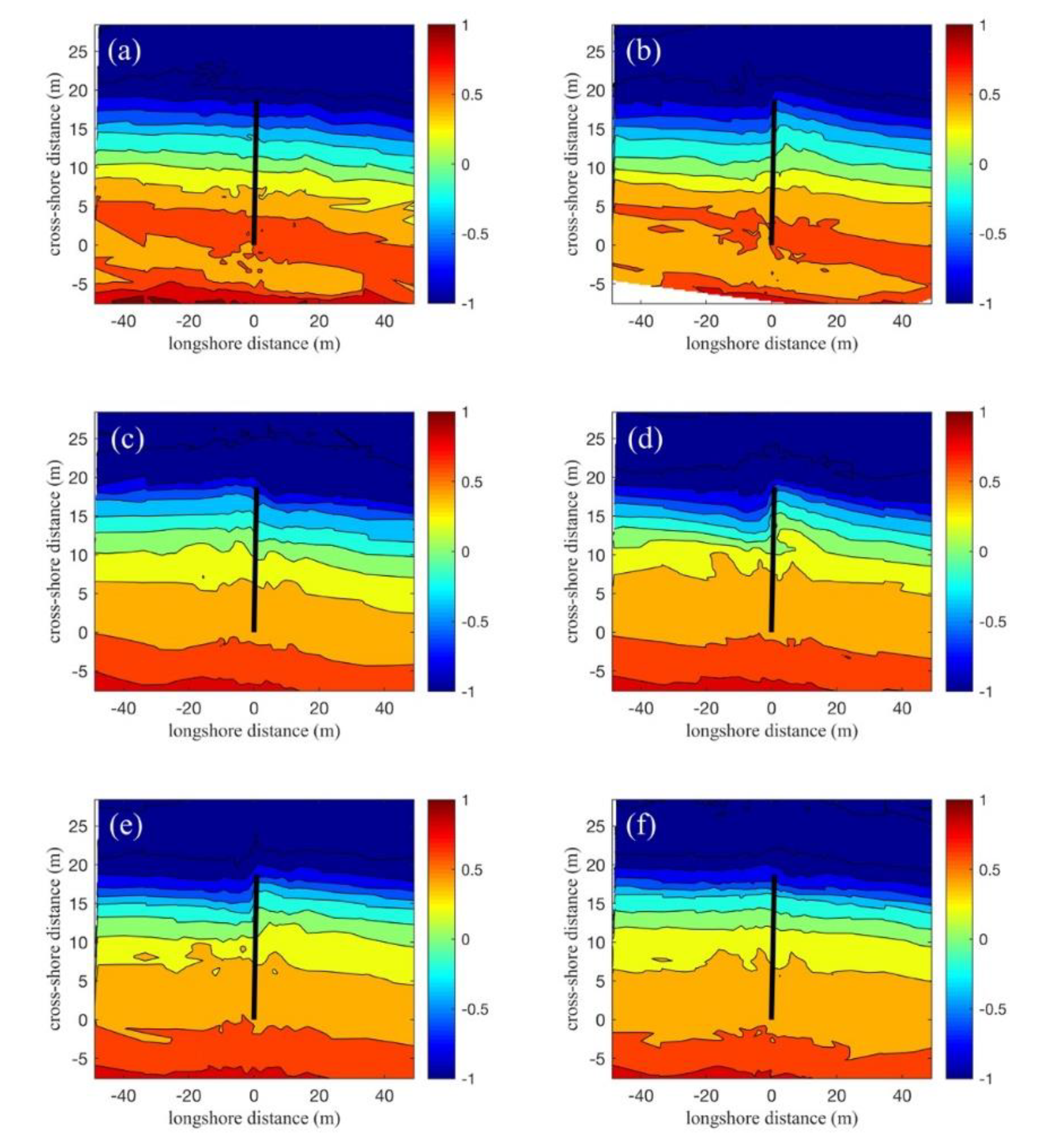
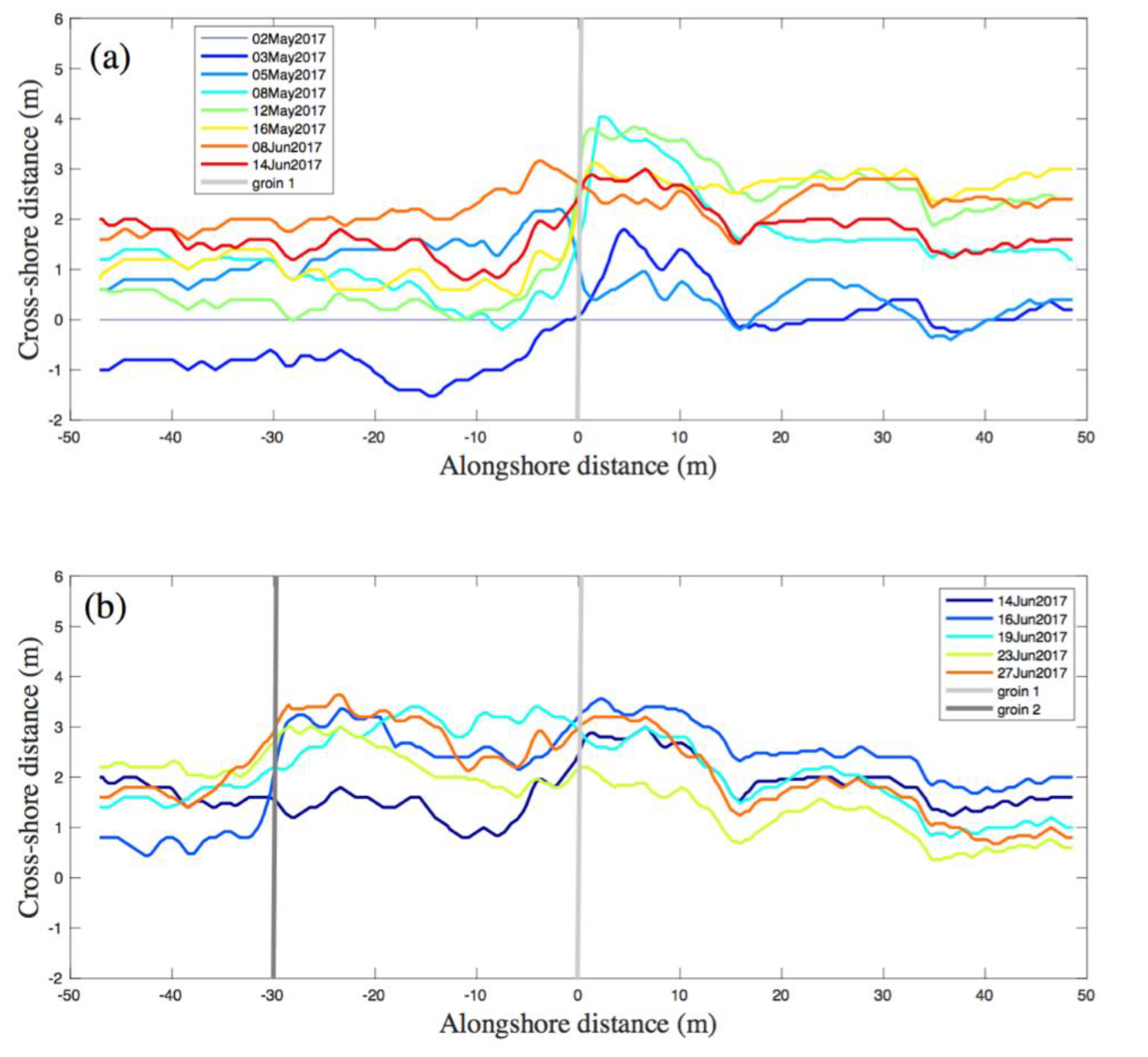
| Parameter Measured | Instrument Type | Sampling Frequency | Start Date | End Date |
|---|---|---|---|---|
| Beach profiles | GPS RTK Leica | 2 h | May 31st, 2016 | June 1st, 2016 |
| - | - | 2 days | May 3rd, 2017 | June 29th, 2017 |
| Waves | ADCP Teledyne RD Instruments | 30 min | May 3rd, 2016 | June 30th, 2017 |
| Sea level | Ultrasonic sensor | 1 min | May 3rd, 2016 | June 15th, 2017 |
| Winds | Weather station | 1 min | May 31st, 2016 | June 1st, 2016 |
© 2020 by the authors. Licensee MDPI, Basel, Switzerland. This article is an open access article distributed under the terms and conditions of the Creative Commons Attribution (CC BY) license (http://creativecommons.org/licenses/by/4.0/).
Share and Cite
Torres-Freyermuth, A.; Hofman, A.; Tuz-Pech, J.C.; Medellín, G.; Roos, P.C. Design and Performance of Permeable Groins on a Low-Energy Natural Beach. J. Mar. Sci. Eng. 2020, 8, 283. https://doi.org/10.3390/jmse8040283
Torres-Freyermuth A, Hofman A, Tuz-Pech JC, Medellín G, Roos PC. Design and Performance of Permeable Groins on a Low-Energy Natural Beach. Journal of Marine Science and Engineering. 2020; 8(4):283. https://doi.org/10.3390/jmse8040283
Chicago/Turabian StyleTorres-Freyermuth, Alec, Anne Hofman, José Clemente Tuz-Pech, Gabriela Medellín, and Pieter C. Roos. 2020. "Design and Performance of Permeable Groins on a Low-Energy Natural Beach" Journal of Marine Science and Engineering 8, no. 4: 283. https://doi.org/10.3390/jmse8040283
APA StyleTorres-Freyermuth, A., Hofman, A., Tuz-Pech, J. C., Medellín, G., & Roos, P. C. (2020). Design and Performance of Permeable Groins on a Low-Energy Natural Beach. Journal of Marine Science and Engineering, 8(4), 283. https://doi.org/10.3390/jmse8040283






